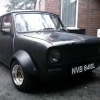First - the resistance you measure is actually pretty meaningless...uhm....how to explain? you might measure the filament of a light bulb or a coil and try to turn that into watts, but you can't. The light bulb filament changes it's resistance as soon as it's juices up - it self current limits.
Coils do the same, but with yet another factor - inductance.
HT coils will spark, but not very well if they don't have a capacitor, what they need is inductance or "ring" - the idea being that when the points open, the coil field collapses (which on it's own would only create a back EMF and arcing at the points, but the capacitor which is already charged drops that charge which causes the coil to "ring" and dump is back EMF more effectively as HT......the points closing again and charging up the capacitor/coil actually cause the spark to be extinguished - it's why dwell angle is important, you need the points to actually have an open period to allow the spark to do it's job, at high speeds, if the duration of opening is too short then the spark will be clipped and may not properly ignite the charge.
Most coils only have a turns ratio of less than a 100, so how come they can hit 10kV from 12V? should only make 1200Volts 'kan? They utilize the fact that as the coil field collapses the capacitor causes this great big spike to form - and 10kV to appear at the HT take off.
CDI's work different - they hit the coil with a big bolt of juice to start with - CDI systems have their own inbuilt gubbins that fires 600 plus volts at the coil.
Yes you can swap coils between systems - don't however try to run a coil designed for CDI on point and condensor ignition unless you're prepared to play games with point gap that reduces the dwell angle significantly - on twin motor bikes the trick is to put the points in series, open them right out (twin points normally do a little "double tap" and then use a CDI coil with dual output as a lost spark setup. It works, but pity the pore sod who tries to set the points correctly later on - the thing will start but will cook the coil in short time.
You're much better to buy a coil specifically designed for high energy systems - a lot of these after market systems are trying to kid the user that they do something more than points, which they don't, they just replace them.
I've got a Triumph T140 that damn near needed tow starting to get it to run - but it's currently on points (I got sent the wrong coils with the electronic kit) and you can start the old lady on sooty plugs wearing flip-flops, the OEM system works perfectly well if set up right and maintained.
so to finally answer your question - a TRUE CDI coil will have a different design compared to a kettering system coil, notwithstanding one may be interchangeable, it just won't be ideal.
![]()
















